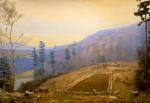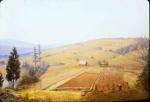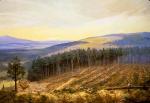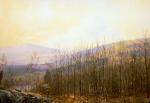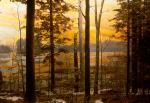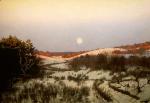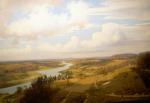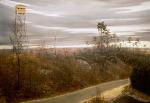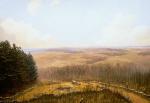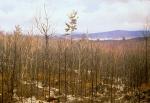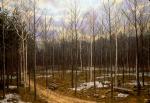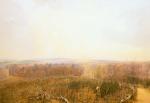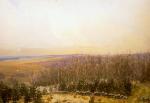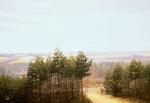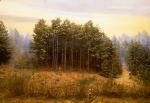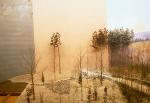In the pre-settlement forest, where Nipmuc people lived before European colonization (and still live in the region today), natural ecological variation across sites and ongoing natural and human disturbance processes led to differences in age, density, size, and species of trees. Notice the large... Read More >
You are here
Dioramas
Landscape History of Central New England
1740 A.D.
For most of the central New England region, European settlement occurred largely during the 18th century, following the tragic forced removal of the Nipmuc people.European settlers dramatically changed the land through forest clearing, hunting, and trapping. The abundance of many species changed... Read More >
1830 A.D.
The peak of deforestation and agricultural activity across most of New England occurred from 1830 to 1880. Across much of New England, 60 to 80 percent of the land was cleared for pasture, tillage, orchards and buildings. Small remaining areas of woodland were subjected to frequent cuttings for... Read More >
1850 A.D.
Beginning in the mid-1800s and continuing for more than a century, farming declined on a broad scale across New England. Abandoned pastures and fields rapidly developed into forests. In central Massachusetts and across much of central New England these forests were dominated by white pines. Read More >
1910 A.D.
As the "old-field" stands of white pine reached middle age, it became evident that they contained a valuable and rapidly growing crop of second-growth timber. As this white pine became marketable portable sawmills appeared across central New England. One of the most common and valuable uses of... Read More >
1915 A.D.
Clear-cutting of the "old-field" white pines led to the succession of mixed hardwoods across much of the landscape. The inability of white pine to sprout after being cut, in contrast to the prolific sprouting of our hardwood species, facilitated this succession. Patterns of succession enhanced the... Read More >
1930 A.D.
One of the characteristic features of the hardwood forest that developed after the clear-cutting of the "old-field" white pines is the predominance of multi-stemmed sprout clumps. Fast-growing species that sprout prolifically -- red oak, red maple, white ash, birches, and black cherry -- are... Read More >
In the period since the dioramas were constructed, the trends in forest development illustrated in the 1930 model have continued. Remarkable expanses of maturing forest extend across a densely populated landscape in the northeastern United States.As these forests grow and mature and as dead and... Read More >
Conservation Issues in the History of New England Forests
This small stand of old-growth forest on the shore of Harvard Pond survived the regional history of land-use and natural disturbance due to its sheltered position at the base of a rocky slope that was unsuited for agriculture.In their size, variety, and unmistakable antiquity, the overstory trees... Read More >
New England's wildlife habitats and food resources have changed dramatically as the landscape has been transformed through time from forest to open fields and woodlots and then back to forest.The shift in our landscape to older, more continuously developing forests may encourage native woodland... Read More >
In New England, as in many other locations, widespread land clearing and agriculture led to soil erosion.In the pre-settlement era, the thick forest cover prevented erosion by intercepting rain and binding the soil with a dense network of roots. Through evapotranspiration, the forests recycled... Read More >
The diorama shows a typical fire-fighting scene from the 1930s, in the era of active suppression of all fires.The fire tower is typical of those built by state and federal agencies throughout the northeastern Untied states in the early 1900s, motivated by a widespread concern over the detection and... Read More >
Because severe fires are much more common in conifer than in hardwood forests, the "old-field" pine forests represented a significant fire danger. Concern by early conservationists over the apparent destructive impacts of fire on forest ecosystems led to a very successful national effort to reduce... Read More >
Forest Management in Central New England
This diorama shows two early treatments to improve the quality of a hardwood stand following the cutting of an old-field pine forest.On the far left is the edge of a 60-year-old white pine stand about to be clear-cut for lumber. Just prior to logging, seedlings and small saplings of hardwood... Read More >
Hardwood stands that have not been thinned or weeded in the first several decades of forest development contain trees of many species, conditions, and sizes. Improvement cutting generally removes inferior stems to favor the best-formed and healthiest trees of desirable species for the future.In the... Read More >
The improvement-cutting stage is eventually followed by thinning, which continues the process of removing trees that compete with selected crop trees.The thinning taking place in the hardwood stand to the right of the road is a "crown thinning" or "high thinning." Its purpose is to give the best... Read More >
This is the same stand as the one shown in the previous diorama, approximately 25 years later. Many of the largest trees are now 12 to 16 inches in diameter and of fine quality for timber. This excellence in growth and form for timber production is due to the weedings and thinnings applied... Read More >
On dry upland sites such as the one pictured, hardwoods often do not grow vigorously and are likely to develop crooked stems, like those in the stand on the far right. Pines, on the other hand, can grow quite well and produce high-quality timber on such sites, provided they are not crowded or... Read More >
Pines are more competitive with hardwoods in areas of dry, sandy soil than on rich, moist sites. On these dry sites it may be advantageous to supplement the hardwood trees with groups of white pine. At the time the dioramas were developed there was a strong emphasis on managing forests for pine... Read More >
Some abandoned fields or other open sites seed in heavily with both gray birch and white pine. Although much shorter-lived than the pine, gray birch grows much more rapidly at first and soon completely overtops the pine. Although the gray birch doesn't cast dense shade, eventually, the white pines... Read More >
One characteristic of white pine in pure stands is the persistence of dead branches that cause loose knots in the resulting lumber. If high-quality, knot-free lumber is desired, the lower branches must be sawed off close to the live stem when the trees are young. Such pruning also produces a more... Read More >
In our local landscape, which typically contains different land uses and soils in close proximity, white pine frequently forms nearly pure stands on recently abandoned agricultural land and dry sites, whereas hardwoods dominate moister and more fertile soils.If we wish to encourage white pine to... Read More >
The shelterwood method is a silvicultural approach through which a new generation of trees is established naturally under the shelter of older trees by a series of partial cuttings intended to:stimulate seed productioncreate favorable seedbed conditions on the forest floorsupply the young seedlings... Read More >
Artistry and Construction of the Dioramas
The artisans of the Guernsey and Pitman studio were justifiably proud of their creations and produced a final diorama documenting the techniques that they had developed to make the remarkably realistic models. Four sections from left to right illustrate initial construction through finished model.... Read More >


